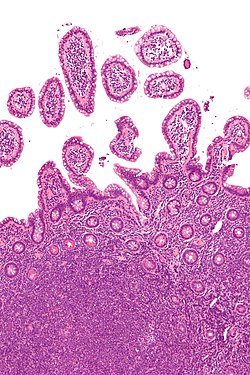
Back لمفوما لاهودجكينية Arabic Linfoma non hodgkiniano AST هاجکین اولمایان لیمفوما AZB অ-হজকিন লিম্ফোমা Bengali/Bangla Limfoma no hodgkinià Catalan Non-Hodgkinův lymfom Czech Lymffoma ddi-Hodgkin Welsh Non-Hodgkin-Lymphom German ލިމްފޯމާ (ނަން ހޮޖްކިންސް) DV Λέμφωμα μη Hodgkin Greek
| Non-Hodgkin lymphoma | |
|---|---|
| Other names | Non-Hodgkin disease |
 | |
| Micrograph of mantle cell lymphoma, a type of non-Hodgkin lymphoma. Terminal ileum. H&E stain. | |
| Specialty | Hematology and oncology |
| Symptoms | Enlarged lymph nodes, fever, night sweats, weight loss, tiredness, itching[1] |
| Usual onset | 65–75 years old[2] |
| Risk factors | Poor immune function, autoimmune diseases, Helicobacter pylori infection, hepatitis C, obesity, Epstein-Barr virus infection[1][3] |
| Diagnostic method | Bone marrow or lymph node biopsy[1] |
| Treatment | Chemotherapy, radiation, immunotherapy, targeted therapy, stem cell transplantation, surgery, watchful waiting[1] |
| Prognosis | Five-year survival rate 71% (USA)[2] |
| Frequency | 4.3 million (affected during 2015)[4] |
| Deaths | 231,400 (2015)[5] |
Non-Hodgkin lymphoma (NHL), also known as non-Hodgkin's lymphoma, is a group of blood cancers that includes all types of lymphomas except Hodgkin lymphomas.[1] Symptoms include enlarged lymph nodes, fever, night sweats, weight loss, and tiredness.[1] Other symptoms may include bone pain, chest pain, or itchiness.[1] Some forms are slow-growing while others are fast-growing.[1] Unlike Hodgkin lymphoma, which spreads contiguously, NHL is largely a systemic illness.[6]
- ^ a b c d e f g h "Adult Non-Hodgkin Lymphoma Treatment (PDQ®)–Patient Version". NCI. 3 August 2016. Archived from the original on 16 August 2016. Retrieved 13 August 2016.
- ^ a b Cite error: The named reference
SEER2016was invoked but never defined (see the help page). - ^ Cite error: The named reference
WCR2014Cp2was invoked but never defined (see the help page). - ^ Cite error: The named reference
GBD2015Prewas invoked but never defined (see the help page). - ^ Cite error: The named reference
GBD2015Dewas invoked but never defined (see the help page). - ^ Kyriakidis I, Pelagiadis I, Stratigaki M, Katzilakis N, Stiakaki E (May 2024). "B–NHL Cases in a Tertiary Pediatric Hematology—Oncology Department: A 20-Year Retrospective Cohort Study". Life. 14 (5): 633. Bibcode:2024Life...14..633K. doi:10.3390/life14050633. PMC 11122206. PMID 38792653.
© MMXXIII Rich X Search. We shall prevail. All rights reserved. Rich X Search